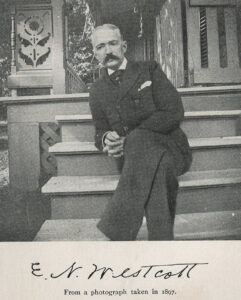
Edward Noyes Westcott on the steps of his home in Syracuse, New York in 1895; from the front matter of The Teller, A Story (1901).
“When I am gone perhaps some of my affairs will turn up trumps but as long as I live luck is dead set against everything I undertake.” So Edward Noyes Westcott said frequently, according to his sister Margaret Muzzey introducing a collection of his letters. Edward was certainly dealt a bad hand – early death of two siblings and his mother, his father suicide, collapse of his business, chronic pain from a fall, the death of his wife at a young age, tuberculosis, and a pile of rejection slips. But six months after his own death Edward’s affairs did come up trumps with the publication of David Harum: A Story of American Life, an immediate and enduring success that brought a small fortune to his three children.
Edward Noyes Westcott, born on September 27, 1846 was the third child of Dr. Amos Westcott, who was a prominent dentist in Syracuse, New York and Clara Babcock Westcott. Edward was a descendant of Stukely and Juliana Westcott in the eighth generation (Edward Noyes Westcott8; Amos7, Gorton6, Reuben5, Amos4, William3, Jeremiah2, Stukely1). He was the half-brother of Frank Nash Westcott, an Episcopal priest and fellow author.
Edward attended school until he was 16. He then went into clerking in a bank. Edward married Jane Dows on June 11, 1874. They had three children, who inherited the profits from their father’s book: Harold, who died young from a fall from a cherry tree, Violet and Philip. Violet married Victor Morawetz, who became a millionaire New York corporate lawyer.
In 1880 he organized the firm of Westcott and Abbott, Bankers and Brokers. A series of adversities wiped out his business and ruined his health. He became secretary to the Syracuse Water Commission. Previous to this, he had been Captain of a Syracuse Militia Company and, while staging an exhibition drill at the Old Weiting Opera House, he fell into the orchestra pit. He landed on the back of his head and never fully recovered from the fall. In failing health, he retired in 1895.
The Story of American Life
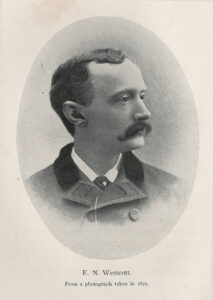
Edward Noyes Westcott in 1875; from The Teller
Suffering from tuberculosis, Edward Noyes Westcott spent the summer of 1895 near Naples, overlooking the bay. In spite of his illness, he began to write for his own amusement. He set down the adventures of a droll old rascal who practiced banking with horse dealing on the side. The story was the start of David Harum: A Story of American Life, the book for which he is chiefly known. He completed the book near the end of 1896. David Harum was refused by six well-known publishers. One publisher said, “It’s vulgar and smells of the stables.”
After revisions, the book was accepted by D. Appleton & Co. on January 17, 1898. Edward Noyes Westcott died on March 31, 1898 not suspecting that appreciation and fame were near. Six months later, David Harum was published. Its popularity was immediate and prolonged. By January 1, 1899, the book was in its sixth large printing. By February 1901, after two years at or near the top of the lists of best sellers, over 400,000 copies had been sold. Thirty-five years after its appearance, more than a million copies had been sold; and, for books published in America, it stood second in popularity only to Quo Vadis (1896), the novel for which Henryk Sienkiewicz won the Nobel Prize for Literature.
The Teller
Edward Noyes Westcott wrote a second tale of American life, a morality tale that reflects Westcott’s own early employment as a bank clerk. The clerk suffers because of his integrity, diligence and regard for the good of others, but in the end is richly rewarded with the management of a company and the embrace of his one and only love. In 1901, D. Appleton and Company published The Teller, A Story along with a collection of his letters edited by Margaret Muzzey “and An Account of His life by Forbes Herman.”
There is a copy of The Teller in the Westcott Society Collection, a 5″ x 8″ hardbound book of 125 pages in good condition. A penciled inscription on the flyleaf to “Miss Weil” by Roger Alston Jones wishes her a Happy New Year, January 1902.
Sources: Betty Acker, “Edward Noyes Westcott, Author of David Harum” (2000); Richard G. Case, “The Westcotts and David Harum” (1973); Findagrave.com; Roscoe Whitman, “Tragedies and Hoax of Some Westcotts” (1945).
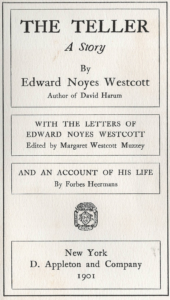
Title page of The Teller (1901)
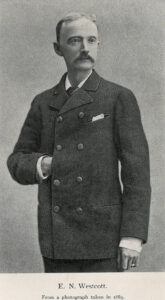
Edward Noyes Wescott in 1889; image accompanying his biography in the The Teller (1901)
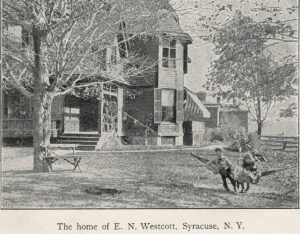
View of the Westcott Home in Syracuse, New York, an illustration in the letters collected in The Teller (1901)
